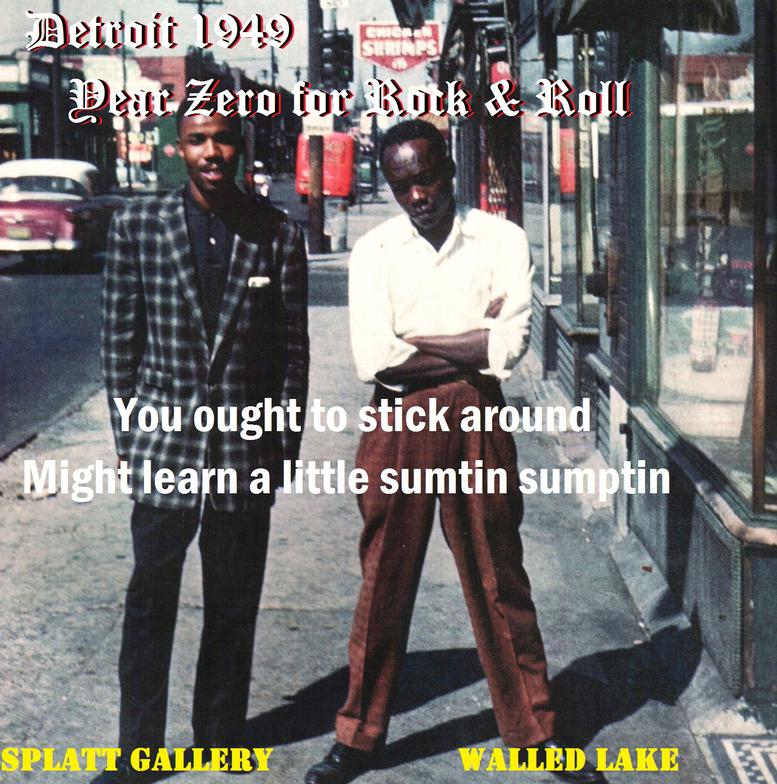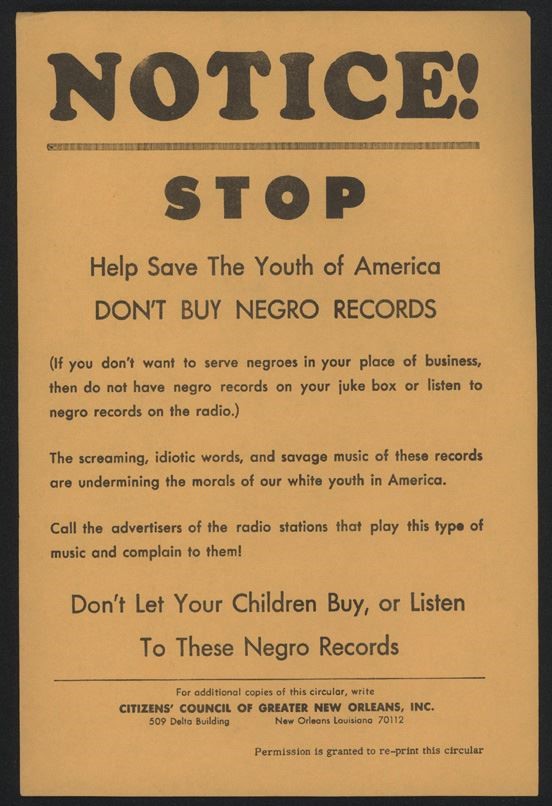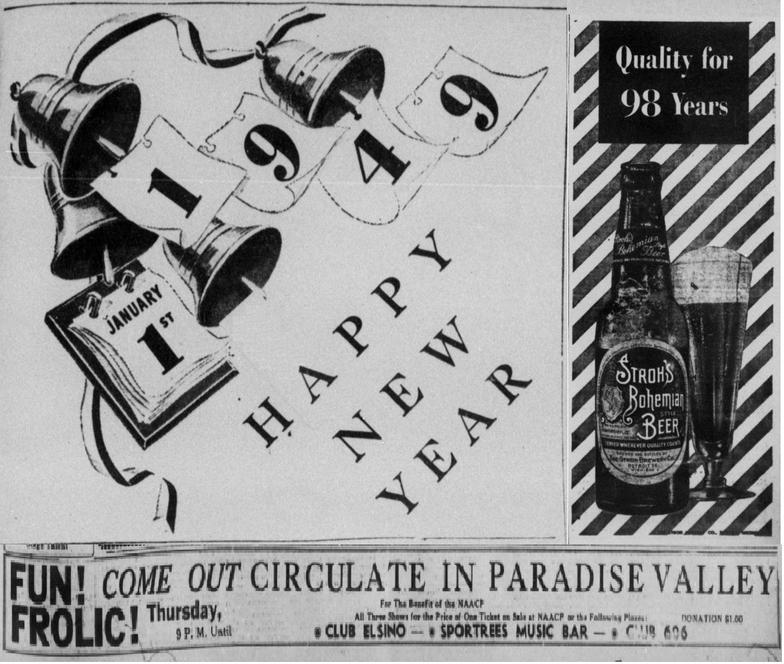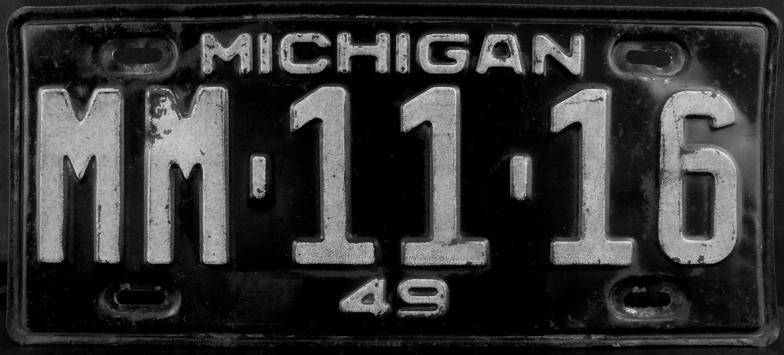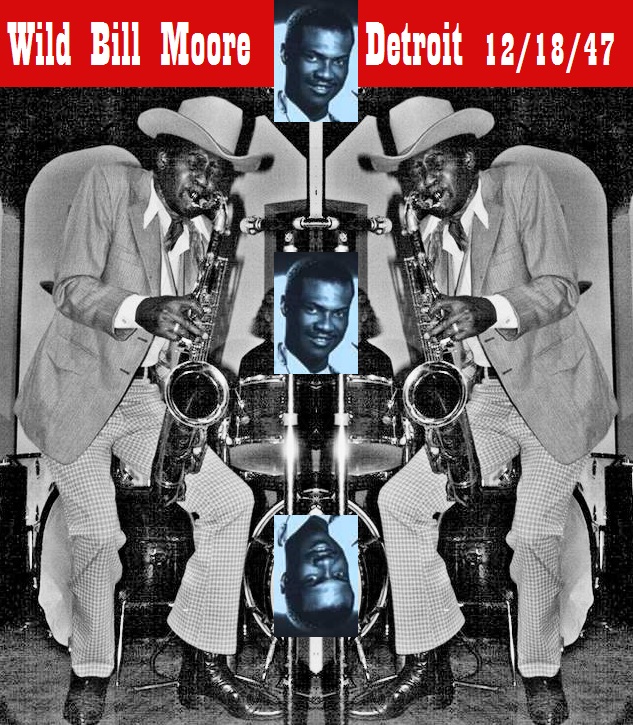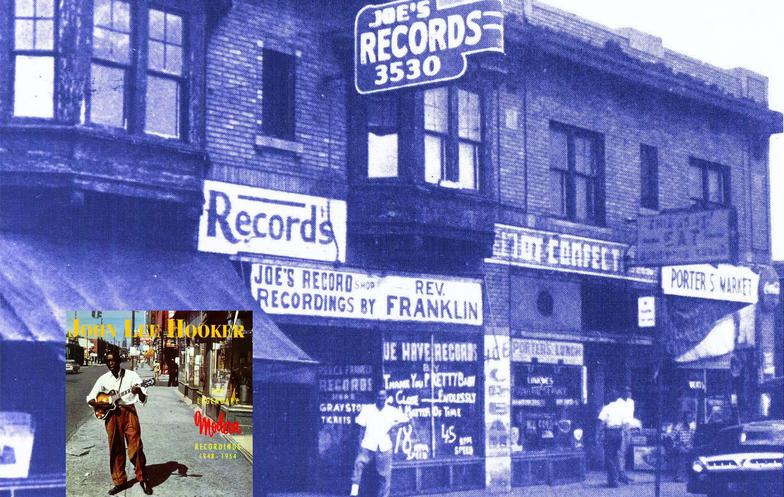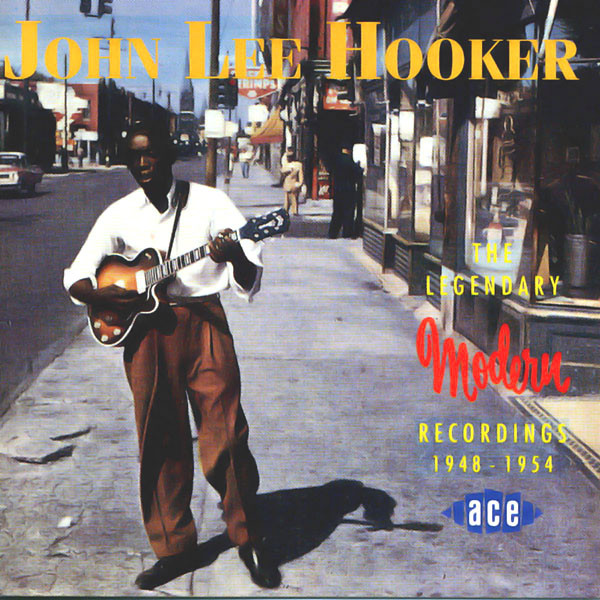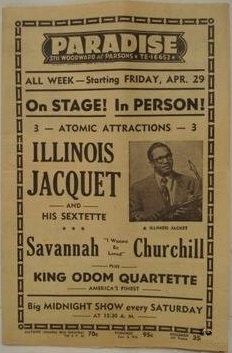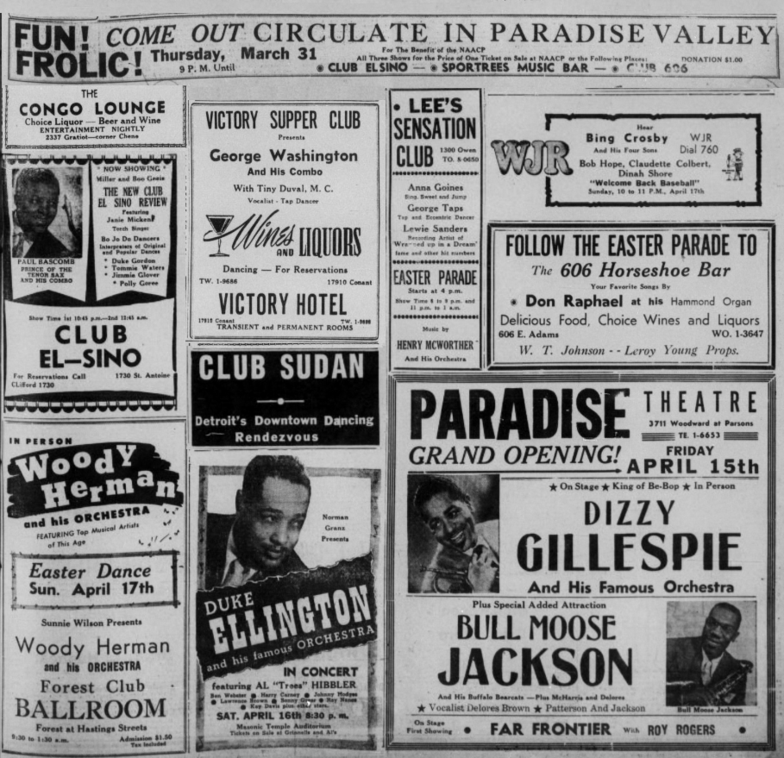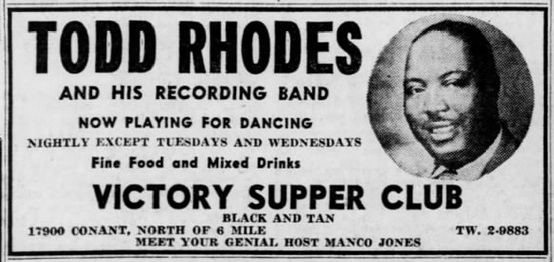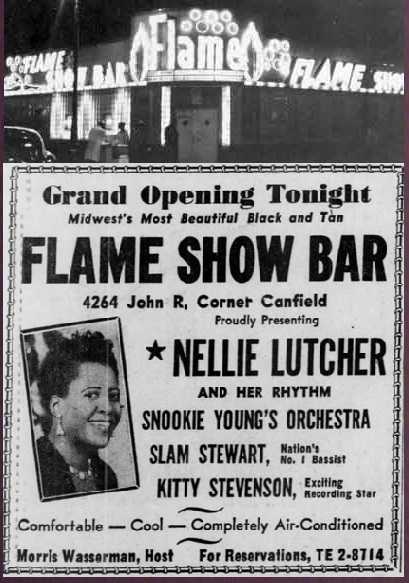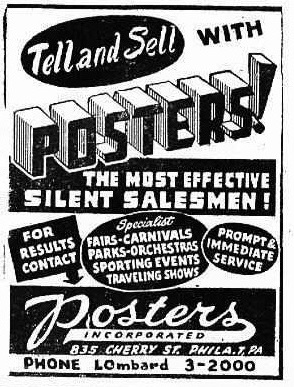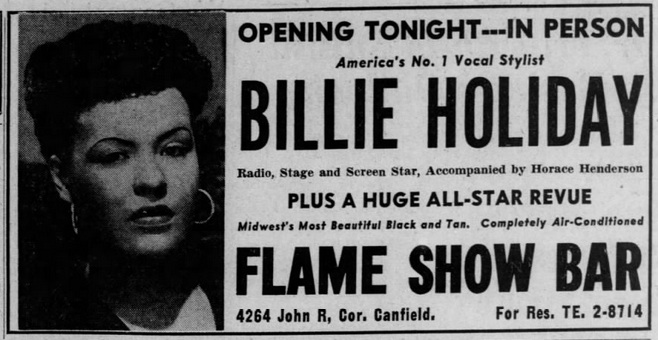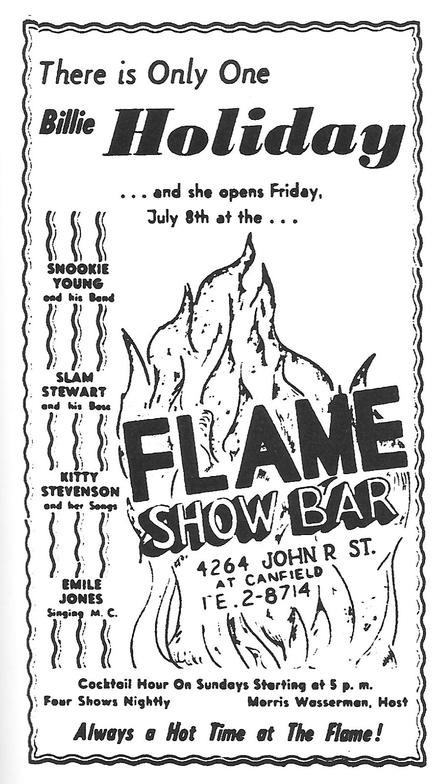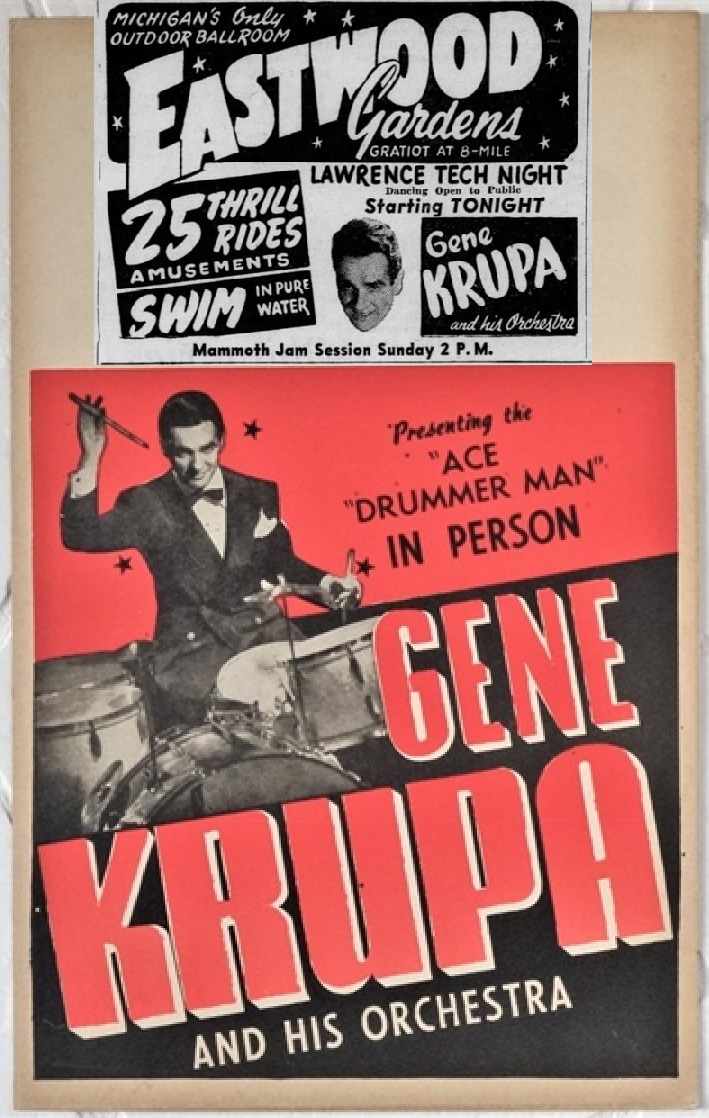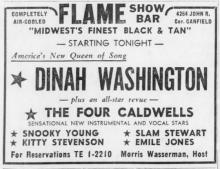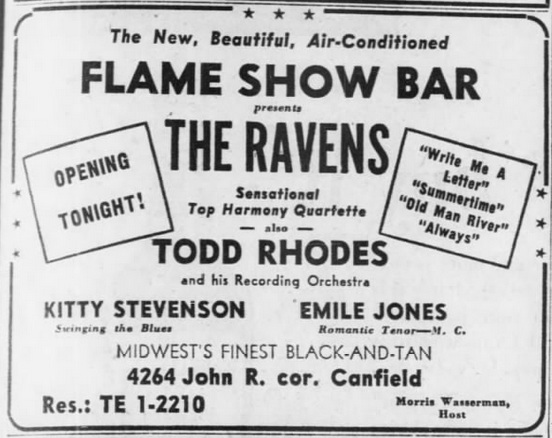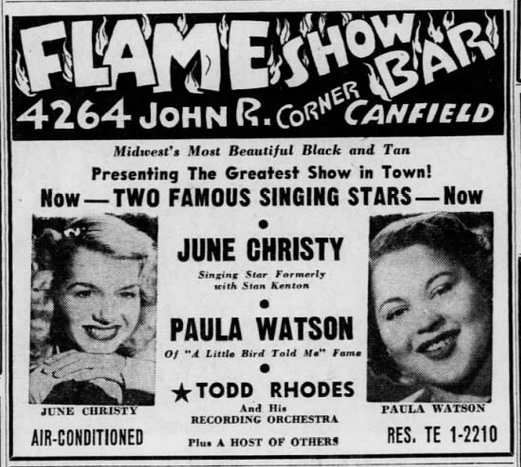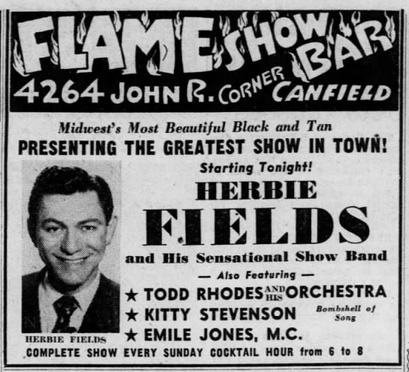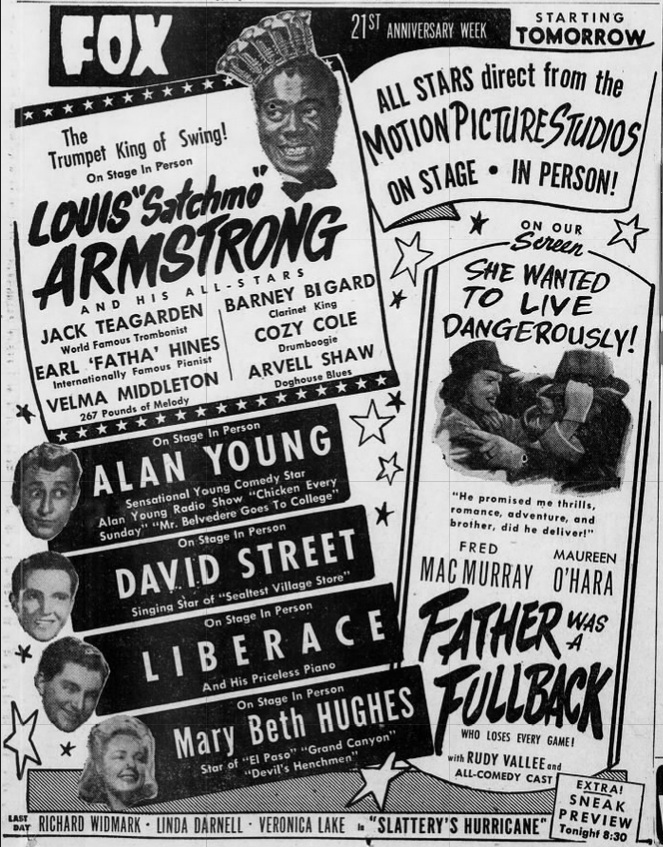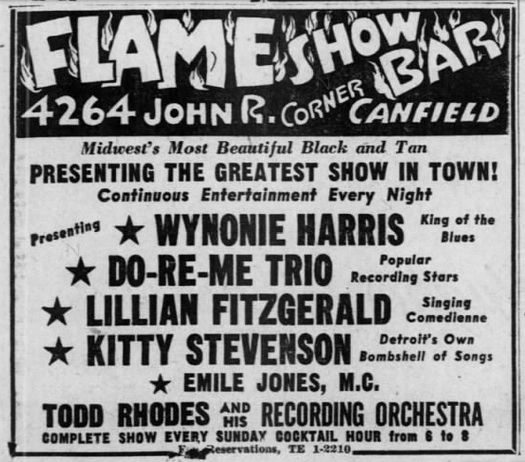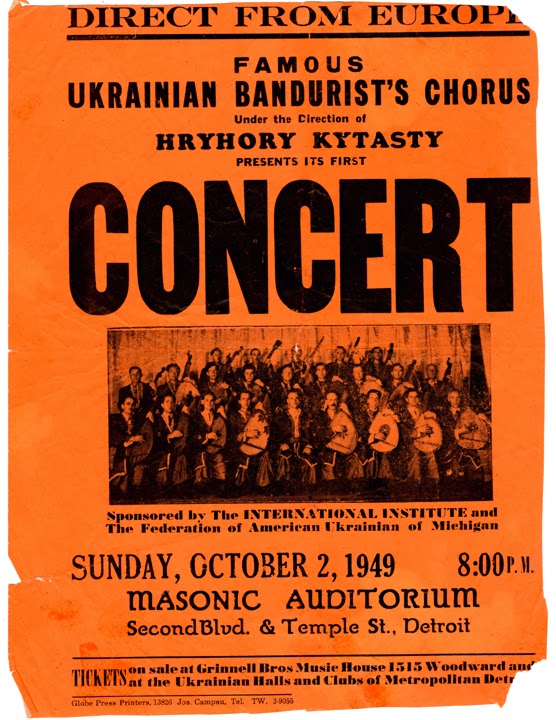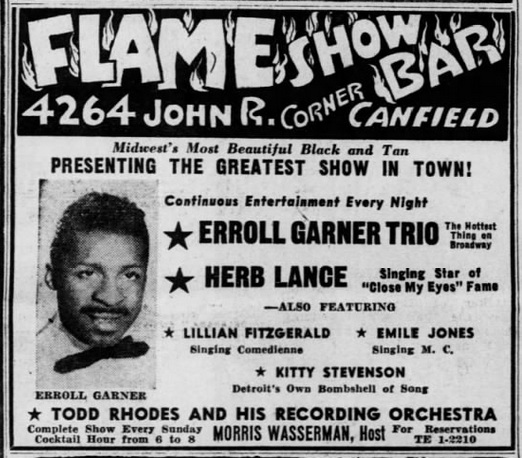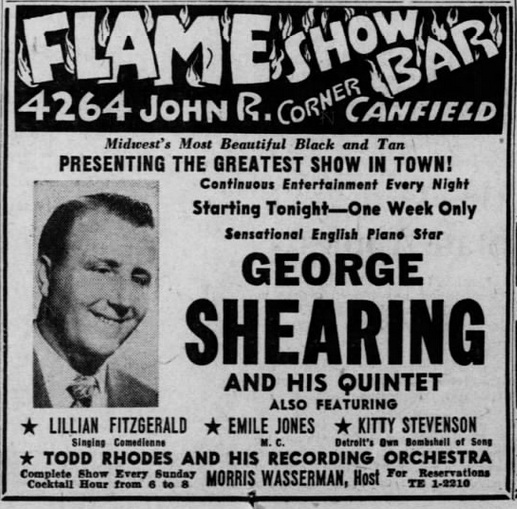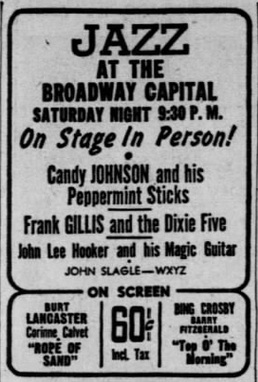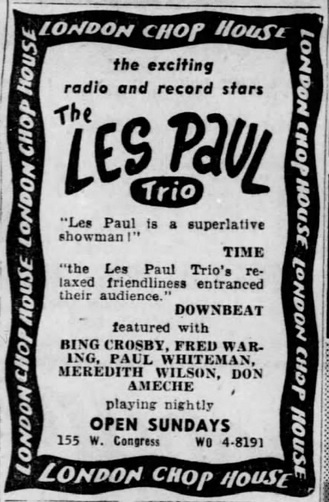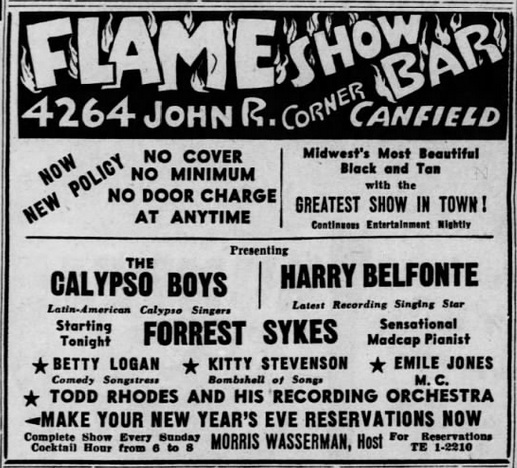Splatt Gallery
Double click here to add text.
Splatt Gallery's History of Michigan Concert Posters
Volume One: 1949 to 1963
Late at night, errant radio signals lost in the crowded airwaves of the daytime, might be captured by lucky radios searching the dial in random locations, to hear strange, new electric sounds emitting from places like Houston, Texas and Philadelphia, PA. Infectious rhythms, a driving foot-stomping beat, a single guitar that could out-sound an orchestra, and a wailing howl that made you sit up. C’mon!
It wasn’t blues. It wasn’t jazz. The songs were about doing something called “rock”.
Shown above, Aaron “Little Sonny” Willis and John Lee Hooker are pictured in front of Joe's Record Shop at 3530 Hastings Street in Detroit in 1959 by French photographer Jacques Demetre. We’re mis-using the photo as our starting point, which is ten years earlier, in 1949.
Here are two early rock records, from Houston, Texas and Philadelphia, PA, respectively, released in 1949.
Goree Carter – Rock Awhile (1949)
https://www.youtube.com/watch?v=H3FNLnFg6Ck
Jimmy Preston – Rock The Joint (1949)
https://www.youtube.com/watch?v=WLKlF7TX2BI
***********************************************************
First, some critical context for the time. We’ll try to stay apolitical, but we’ll just say, “never forget” this. We do like the line, "The screaming, idiotic words, and savage music..." We’re calling it “the first rock poster”.
Ringing in the New Year with a few ads from the January 1, 1949 issue of The Detroit Tribune, at the time, Michigan’s oldest existing Negro newspaper. Paradise Valley is the place for fun and frolic. For a one dollar donation to the NAACP, you can catch three shows at Club El Sino, Sportrees Music Bar, and Club 606.
And so, we pick 1949 as the year to start our History of Detroit Rock Posters, or more accurately a History of Michigan Concert Posters, since we go beyond Detroit and we go beyond Rock.
In order to find the first rock concert poster, we need to find the first rock concert (which we do, in Cleveland, Ohio in 1952), and we’d like to go a bit further back to find the first “rock music”, a subject of unresolvable debate among music historians to this day. Many of them consider the 1951 song “Rocket 88” by Jackie Brenston and his Delta Cats (better known as Ike Turner and his Kings of Rhythm) as the first rock and roll record, but that is relatively far in the future from where we are.
The following video provides snippets of songs that had raucous sounds, wailing saxophones, vocals, and/or guitars, taboo subject matter, and even the lyrics “rock” and “roll”, that were on the fringes of blues, jazz, and country music, pushing the envelopes of boogie-woogie, “race music”, and honky-tonk, going back to 1927, up to 1949.
On it, you’ll find two Detroit musicians, John Lee Hooker and Will Bill Monroe, whose records slightly pre-date 1949, coming out in late 1948, Monroe’s is even titled, “We’re Gonna Rock, We’re Gonna Roll”. We’ll be looking at both of them in greater detail in following posts.
Roots of Rock and Roll (1927 – 1949)
https://www.youtube.com/watch?v=H_lqJk5JzeA
William “Wild Bill” Moore was born in Detroit Michigan and began playing the alto saxophone at an early age. However, prior to his musical career, he was an amateur boxer, winning Michigan's Golden Gloves light heavyweight championship in 1937, before briefly turning professional. By the early 1940s, Moore abandoned his boxing career in favor of music, and was inspired by musicians Chu Berry and Illinois Jacquet to switch to tenor saxophone.
In 1944, he made his recording debut, accompanying Christine Chatman, the wife of Memphis Slim, for Decca Records. Between 1945 and 1947, Moore was performing and recording in Los Angeles with Slim Gaillard, Jack McVea, Big Joe Turner, Dexter Gordon, and played on Helen Humes’ hit recording, "Be-Baba-Leba".
In 1947 he moved back to Detroit and began recording with his own band, which included baritone player Paul Williams, later famous for "The Hucklebuck". In December of that year, he recorded "We're Gonna Rock, We're Gonna Roll" for the Savoy label which was a modest hit and is remembered today as one of many candidates for the first rock and roll record. It was one of the first records played by Alan Freed on his "Moondog" radio shows in 1951. However, by the standards of its time it was quite a primitive recording, notable mainly for the juxtaposition of the words “rock” and “roll”, and the battling saxophones of Moore and Williams. In 1949, he cut "Rock And Roll", reportedly featuring Scatman Crothers on vocals.
Many years later, Wild Bill Moore was the sax player on Marvin Gaye's classic What's Going On album, you all know his iconic solo on the track "Mercy Mercy Me".
Wild Bill Moore – We’re Gonna Rock, We’re Gonna Roll (1948)
https://www.youtube.com/watch?v=dFnTg2THWFY
Record stores figure prominently in our tale, and we might begin with Joe’s Records in Detroit, Michigan. In 1945, Joe Von Battle opened the store on Hastings Street, selling from his own collection and ultimately building up an inventory of tens of thousands of records. He also set up a recording studio in the back of the store which became a mecca for traveling and local musicians, notably John Lee Hooker and Paul “Hucklebuck” Williams.
Williams immortalized the shop with his first record, “Thirty Five Thirty” which was the shop’s address on Hastings Street. Hastings Street was the subject of a lot of records cut at Joe’s, including “The Hastings Street Opera” by Bob White, who was known as The Detroit Count. The street’s fame even spread overseas as a photographer from France named Jacques Demetre made a pilgrimage to Detroit in 1959 to take pictures of the place and the people. Rare for the time, he used color photography, with one of his shots becoming an iconic John Lee Hooker album cover.
Joe would also record the sermons of Reverend C.L. Franklin at the nearby New Bethel Baptist Church and made the earliest recordings of the Reverend’s daughter, Aretha.
Hastings Street was “urban renewed” to make way for the Chrysler Freeway in 1960 and Joe moved the shop to 12th Street where it was tragically destroyed in the 1967 riot rebellion.
The Detroit Count –Hastings Street Opera (1948)
https://www.youtube.com/watch?v=tHKuB4NdTSU
Paul Williams –Thirty-Five Thirty (1947)
https://www.youtube.com/watch?v=jpBRLvhGI0I
Paul Williams – The Hucklebuck (1949)
https://www.youtube.com/watch?v=Du6Y7umZRH8
The cover of the 1993 release, “John Lee Hooker – The Legendary Modern Recordings” with photo by Jacques Demetre on Hastings Street in Detroit.
Quoted from the concert database:
“The Paradise Theater was as important to Detroit as the Apollo Theatre was to Harlem. Opened Christmas Eve 1941, when new owners Ben and Lou Cohen reopened Orchestra Hall as the Paradise Theatre, the place that Detroit audiences once went to hear Prokofiev, Gershwin and Horowitz began featuring contemporary talent such as Duke Ellington, Louis Armstrong, Lena Horne and Pearl Bailey. The theater’s name was taken from Paradise Valley, the area just east of Woodward Avenue, home to a large percentage of Detroit’s African-American community and to the principal black entertainment district at St. Antoine and Adams streets.”
This poster is for a show by Illinois Jacquet, Savannah Churchill, and the King Odom Quartette at the Paradise Theater in Detroit, Michigan, April 29, 1949. What we particularly like about this poster is that the acts are billed as “3 – Atomic Attractions – 3”.
The “Atomic Age” was the title of a 1945 book that promised wonders from nuclear energy, including cars that would run for year on a pellet the size of a vitamin pill, home energy that would be “too cheap to be metered”, and golf balls that could never be lost.
A little slice of life in Detroit, Michigan in the Spring of 1949.
“Fun! Frolic! Come Out, Circulate in Paradise Valley”, with Woody Herman at the Forest Club Ballroom, Duke Ellington at the Masonic Temple Auditorium, Dizzy Gillespie and Bull Moose Jackson at the Paradise Theatre, an Easter Parade that starts off at Lee’s Sensation Club and winds its way over to the 606 Horseshoe Bar, the new Congo Lounge, the Victory Hotel, Club Sudan, Club El-Sino, and Sportrees Music Bar, all at your service while WJR radio broadcasts a “Welcome Back Baseball” show.
An ad for Todd Rhodes at the Victory Supper Club in Detroit, Michigan, May 19, 1949. A pianist, Rhodes came to Detroit in 1928 to join the famed McKinney’s Cotton Pickers jazz band. He left the band in 1934, but remained in Detroit, forming the Todd Rhodes Orchestra, sometimes going by the name of Todd Rhodes & His Toddlers.
He made a number of recordings for Bernard Besman’s Sensation label, such as “Bell-Boy Boogie”, named for DJ Ed McKenzie, the original Jack the Bellboy, “Sportree’s Jump”, named for the Detroit club, “Pot Likker”, which made it to #3 on the R&B charts in 1949, and “Blues For The Red Boy”, which DJ Alan Freed adopted as a theme song, re-naming it “Blues For The Moondog”.
Todd Rhodes Orchestra – Pot Likker (1949)
https://www.youtube.com/watch?v=J0F3GGQ1M8Q
Todd Rhodes Orchestra – Blues For The Red Boy (1948)
https://www.youtube.com/watch?v=o-QOz1kQu3g
On June 24, 1949, the Flame Show Bar opened in Detroit, Michigan, the Grand Opening featured Nellie Lutcher, along with Snookie Young’s Orchestra, featuring Slam Stewart, the “nation’s #1 bassist”, and Kitty Stevenson, an “exciting recording star” from Detroit.
That line-up performed for six straight nights at what the newspaper called the “new black-and-tan spot” in town, and wrote it was Lutcher’s “first Detroit show bar appearance” apparently making a distinction of the venue, as she had performed at the Paradise Theater a year earlier.
Billboard magazine started out in 1894 as a magazine about posters and postering, hence the publication’s name, The Billboard. At the turn of the century, before the advent of the mass communication of radio and television, the poster or the billboard was the only method, aside from newspapers and magazines, for promoting products and events.
In 1900, Billboard began to cover the emerging modern marvels of technology such as the jukebox, coin-operated machines, the phonograph, the graphophone, the gramophone, the Victrola, the grafonola, silent, then sound-enabled film, wireless radio, television and record players. And the magazine created its most enduring feature: the Charts.
Billboards first chart, “Popular Songs Heard in Vaudeville Theaters Last Week” appeared in 1913. The “Jukebox Record Buying Guide” (later called “Most Played in Juke Boxes” chart) debuted in April 1938, the “National List of Best Selling Retail Records”, a ten-position chart appeared in July 1940, and “Disks With Most Radio Plugs” (later “Most Played by Jockeys”) started in January 1945. Ten years later, in 1955, these three charts were consolidated into the “Top 100”, renamed the “Billboard Hot 100” in 1958, and along with the “Billboard 200”, a chart for albums created in 1956, the prevailing standard of measurement for the music industry was established.
Specialized charts such as “Children’s Records”, “Classical Artists”, “Folk Records”, and “Race Records” were created, and Billboard staff are credited with inventing at least two musical genres; Country & Western and Rhythm & Blues.
“Folk” music had become associated with communists due to Senator Joseph McCarthy’s disparaging of left-leaning artists such as the Weavers and Pete Seeger, leading Billboard editor Tom Ackerman to coin the term “Country & Western” to combine the less-suited categories of “Folk”, “Rustic”, “Hillbilly” and “Cowboy” classifications, the “Western” was dropped in 1962 to become simply the “Hot Country Singles”.
And in June 1949, Billboard staff reporter Jerry Wexler, who would later become vice-president of Atlantic Records and shepherd the career of Aretha Franklin, coined the more enlightened term “Rhythm & Blues” to replace the “Race Records” which had originated as the “Harlem Hit Parade”.
This ad from the June 25, 1949 issue, long after the magazine had evolved into the arbiter of the overall entertainment industry, reminds us that posters are “the most effective silent salesmen!”
Following their Grand Opening, the Flame Show Bar in Detroit, Michigan hosted legendary singer Billie Holiday for a fourteen-show run, July 8-21, 1949. No stranger to Detroit, Holiday had already performed in Detroit over fifty times before this, appearing at the Graystone Ballroom, the Fox Theatre. Eastwood Gardens, the Paradise Theater, Club Zombie, the Detroit Music Hall, and the Detroit Institute of Arts.
An ad for Billie Holiday at the Flame Show Bar in Detroit, Michigan for a fourteen-show run, July 8-21, 1949. No stranger to Detroit, Holiday had already performed in Detroit over fifty times before this, appearing at the Graystone Ballroom, the Fox Theatre. Eastwood Gardens, the Paradise Theater, Club Zombie, the Detroit Music Hall, and the Detroit Institute of Arts. Her earliest visits were with the orchestras of Count Basie, Artie Shaw, and Lionel Hampton before starting her solo career in 1943.
This was her debut at the Flame, which had its Grand Opening just the week before. Billie Holiday would return to Detroit for well over a hundred more shows up until her passing ten years to the date from these shows, on July 17, 1959 at age 44.
A tour-blank for drummer and orchestra leader Gene Krupa from 1949, which could have been used for his five-night gig at the Eastwood Gardens in Detroit, Michigan from July 22, 1949 through July 26th.
Eastwood Gardens was an open-air ballroom located in the Eastwood Park amusement center at 8 Mile and Gratiot, conveniently a turning point for the streetcars, where, as the ad reads, there were thrill rides, twenty-five of them, and you could swim “in pure water”.
Billboard magazine reported on the outcome of Krupa’s shows at the Eastwood:
EASTWOOD GARDENS LOSES THREE DAYS IN MARIJUANA CASE
Detroit, July 30 - Eastwood Gardens, huge outdoor ballroom at Eastwood Park here, was closed for three days this week, Tuesday thru Thursday, as the result of marijuana charges pressed against three members of the Gene Krupa orchestra, which opened the Friday (22) for a week's stand. Krupa himself was exonerated of responsibility after investigation by police and federal narcotics officers.
Gene Krupa – Angry Drumming (1948)
https://www.youtube.com/watch?v=lapj4VEPGo0
The third act to come to the Flame Show Bar in Detroit, Michigan was “America’s New Queen of Song” Dinah Washington, August 5-18, 1949. Washington was also no stranger to Detroit, she had appeared in the city over 75 times before this, performing at the Paradise Theater, the Downtown Theater, and the Frolic Show Bar.
The fourth act to come to the Flame Show Bar in Detroit, Michigan was a group from Harlem, New York called the Ravens, August 19, 1949 through September 1st. The Ravens had previously appeared in Detroit over twenty times before this, at the Paradise Theater, and the Michigan State Fairgrounds Coliseum. The Todd Rhodes Orchestra becomes the house band at the Flame.
The fifth act to come to the Flame Show Bar in Detroit, Michigan featured female singers June Christy and Paula Watson, September 2-15, 1949.
The sixth act to come to the Flame Show Bar in Detroit, Michigan was Herbie Fields & his Sensational Show band, September 16-22, 1949.
The Fox Theatre was constructed during the third wave of theater construction in Detroit, Michigan, opening to the public on September 21, 1928. The above poster/ad is for the theatre’s 21st anniversary on September 19, 1949. Louis Armstrong was the headlining act, with a crown of horns that ended up looking like a rack of lamb. Liberace is among the supporting acts, and as was typical for the big shows, a movie screening was also included.
The seventh act to come to the Flame Show Bar in Detroit, Michigan featured Wynonie Harris, the Do-Re-Me Trio, Lillian Fitzgerald, and Kitty Stevenson, all backed by the Todd Rhodes Recording Orchestra, September 23, 1949 through October 6th.
The Ukrainian Bandurist's Chorus had been kicking out the jams since 1918 in Ukraine, and in 1949 they escaped the persecution of the Soviets with the assistance of allied forces who brought them out of refugee camps to establish a new home base in Detroit, Michigan. Here’s a poster for their concert at Masonic Auditorium in Detroit, October 2, 1949.
The eighth act to come to the Flame Show Bar in Detroit, Michigan featured the Earl Garner Trio, Herb Lance, Lillian Fitzgerald, and Kitty Stevenson, all backed by the Todd Rhodes Recording Orchestra, October 8-20, 1949.
The ninth act to come to the Flame Show Bar in Detroit, Michigan featured George Shearing & his Quintet, Lillian Fitzgerald, M.C. Emile Jones, and Kitty Stevenson, all backed by the Todd Rhodes Recording Orchestra, October 21-27, 1949.
John Lee Hooker made his way to Detroit, Michigan in 1943, taking a job with the Ford Motor Company during the days and spending the nights in the clubs and bars on Hastings Street. Guitar players were scarce, as pianists were the order of the day in the entertainment district, and Hooker soon traded his acoustic guitar for an electric in order to be louder.
In 1948, Hooker recorded some demos for Bernie Besman in the back of Barbee’s Record Store that got picked up by Modern Records in Los Angeles and yielded the single “Boogie Chillen” that became the best-selling “race record” of 1949.
Incidentally, it was in June 1949 that a Billboard staff writer named Jerry Wexler, who would go on to become a partner at Atlantic Records and shepherd the career of Aretha Franklin, suggested, and made, the change of the Billboard Race Records chart to the Billboard Rhythm & Blues chart.
Although Hooker had been performing on Hastings Street for nearly six years, the earliest announced performance is this show on November 5, 1949 at the Broadway Capital Theater, which is now the location of the Detroit Opera House. In the late-1940’s it was the domain of Stan Kenton, Ella Fitzgerald and Cab Calloway, and had begun a “Jazz at the Broadway” series in October 1949, headlined by Floyd “Candy” Johnson, who on this night invited “John Lee Hooker and his Magic Guitar” onto the stage.
John Lee Hooker – Boogie Chillen (1948)
https://www.youtube.com/watch?v=G4pp02_GN9A
An ad for the Les Paul Trio appearing at the London Chop House in Detroit, Michigan, December 5-11, 1949, concluding the stand just eighteen days before his wedding to Mary Ford, at a small ceremony in Milwaukee, Wisconsin, attended by their close friends, the Millers, George and Bertha, who were the best man and maid of honor, and also the parents of a six-year old boy named Steve, who liked to “bang away” on a guitar.
An ad for the Flame Show Bar in Detroit, with the first known Michigan appearance by singer Harry Belafonte, December 9-14, 1949.
1950


